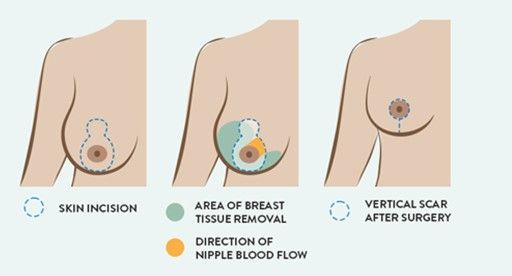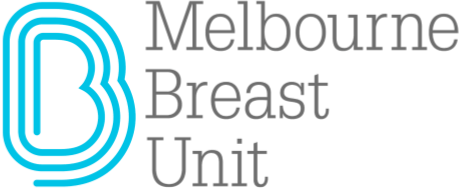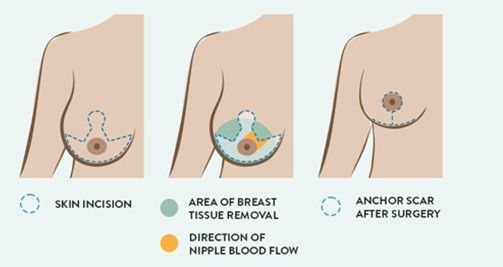Macromastia
Bilateral Breast Reduction
What is a Breast Reduction?
Breast reduction, also known as reduction mammoplasty, is a surgical procedure that reduces the size of overly large and out of proportion breasts, particularly to relieve symptoms and improve other issues, such as:
- Pain in the back, neck, shoulders and breasts
- Grooving of the shoulders caused by bra straps
- Inflamed, reddened skin under the breast (intertrigo)
- Difficulty finding a suitable bra and other clothing
- Difficulty exercising
- Loss of confidence
In Australia breast reduction is categorised as those that are medically indicated (due to the above reasons) and those that are cosmetic only. The differentiation determines whether you will be covered by Medicare and/or what level of private cover you require. If you require a medical breast reduction then we are happy to assist you at Melbourne Breast Unit.
Having realistic expectations is important when considering breast reduction surgery. The initial result cannot be expected to last a lifetime. Future weight loss or gain and hormonal changes may change the appearance and shape of the breasts and most patients will experience ptosis (‘drooping’) of the breasts with age. It is also best to wait until the breasts are fully developed (usually by the age of 18) to obtain the best long term outcome from this surgery.
It is also recommended that patients have some form of breast imaging prior to any breast surgery to ensure no underlying pathology. The type of imaging required will vary depending on age and other risk factors.
How is it performed?
The operation is performed under a general anaesthetic and takes around 3 hours. The surgeon will do some skin marking prior to you going to sleep. This is to mark the new position of the nipple as well as the tissue that is to be removed. The most commonly used technique is the Wise pattern (or anchor) approach (see below diagram). Dissolving sutures under the skin will be used.
There is usually no need for any drains or catheters and most patients can go home after 1-2 nights. Patients can expect to have a Prevena® Restor Bellaform Negative Pressure Wound Therapy Dressing which entirely covers the breasts. This is connected to a small pump that is carried until the dressing is removed, which is up to 14 days. Further information about this will be provided to you, but this dressing helps support the breast, improve blood flow, expedite healing and decrease swelling.

How long is the recovery?
While every patient is different, most patients can expect full recovery by 6 weeks. Initially you will have some pain and discomfort, but you will be given pain relief to go home even though the expected level of pain is not severe. Some bruising and swelling is normal during this time and will usually resolve by 3 months.
It is recommended not to work or do anything more strenuous than walking for the first 2-3 weeks. Keeping the breasts supported and still is important for your recovery. You will be asked to obtain a soft, supportive post surgical bra which are easily found in most department stores. Expect that you will need to wear this bra at all times except showering for the full 6 weeks and you will need to sleep on your back during this time. After your first post operative review at about the 2 week mark the dressing will be removed and you will be advised if you can resume driving, work and small tasks.
Any operation leaves a permanent scar. Infection can cause a wound to reopen, which may lead to problems with scar formation such as stretching or thickening. At first, even without any healing problem, the scars will look red, slightly lumpy and raised. Regular massage of the scar using a light, non-perfumed moisturising cream and using sun protection measures such as a factor 30 sunblock should help it to settle and fade in time. This may take up to two years. Some people develop keloid or hypertrophic scars which are raised, itchy and red. If you already have a tendency to produce scars like these then please discuss this with your surgeon. In most patients the scars soften and flatten to become less noticeable.
.
Risks
All surgical procedures carry the risk of complications or undesired outcomes. You will need to consider whether the benefits outweigh the risks for you. The possible risks include, but are not limited to:
- Loss, or partial loss, of the nipple(s)
- Change in sensation of the nipple(s), either numb or more sensitive
- Difference in size or appearance between the breasts (asymmetry)
- Unexpected cosmetic deformity
- Inability to breastfeed
- Wound complications and delayed healing
- Unsightly scarring
- Bleeding
- Infection
- Seroma
- Breast oedema
- Fat or skin necrosis
- Changes to diagnostic imaging
- Anaesthetic risks, such as allergic reactions or blood clots.
- Need for further surgery
For any further information feel free to contact us on (03) 9419 1166
or via email breast.unit@breastunit.com.au




